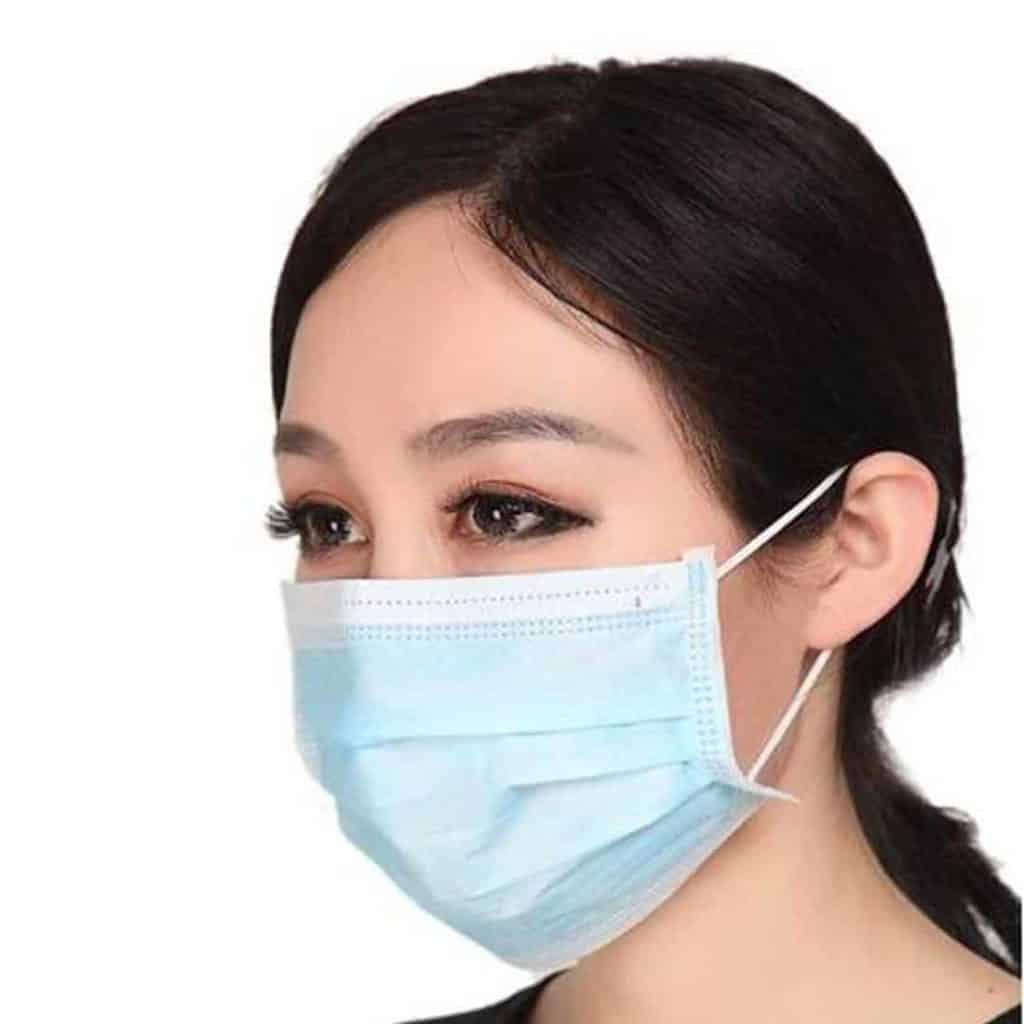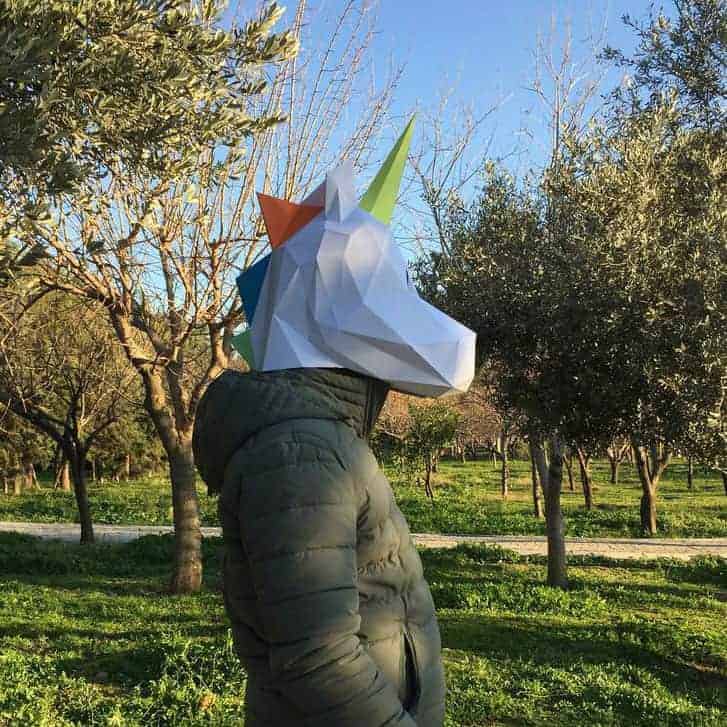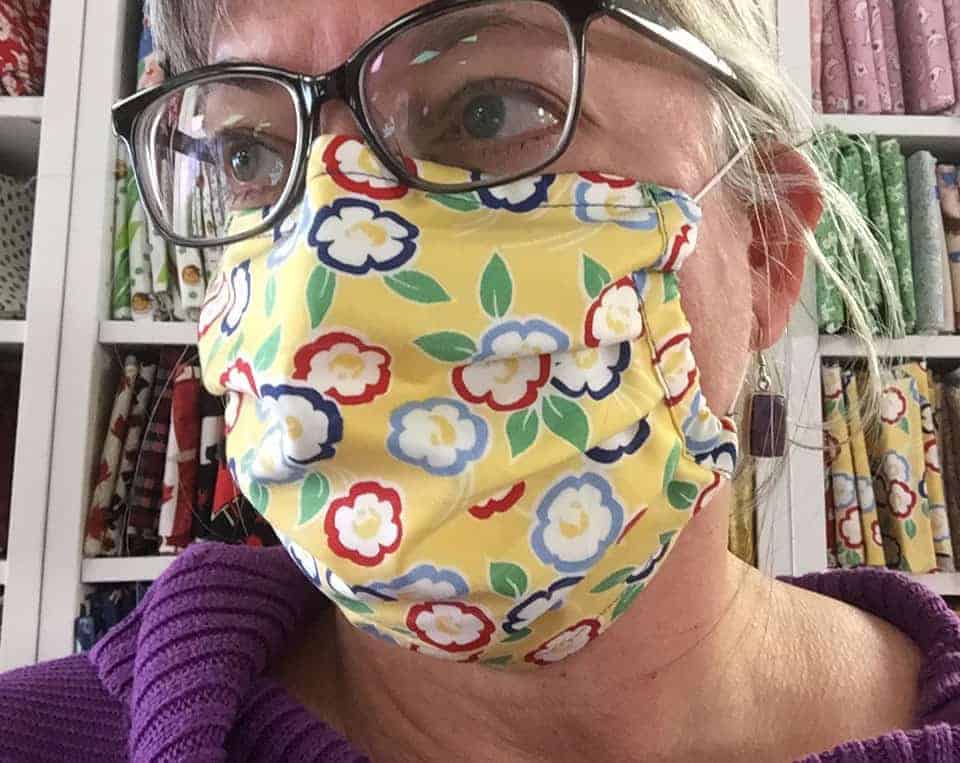Home sewers help make masks
In this age of COVID-19, with the availability of medical face masks dwindling, many seamstresses and sewers have been taking to their sewing machines to help by making home-sewn masks.
Unfortunately, if you don’t use it correctly, a sewn face mask can often be more dangerous than doing nothing. That’s why it’s important to be very careful putting your mask on and taking it off.
I’ve designed a mask that can be washed and can withstand the high heat of sterilization. You’ll find a video that shows you how to make and use one at the end of the article, along with a tutorial for a scrub cap to make wearing the mask more comfortable.
Here’s a rundown of types of masks and when to use them, and some reminders of other ways to protect yourself and others.
PPEs, aka personal protective equipment
The most common PPE’s (personal protective equipment) used during an outbreak are gloves, masks and face shields. But what are we protecting ourselves from? The answer: particulate in the air expelled by infected people. That’s the mist expelled when someone coughs or sneezes.
COVID-19 is a virus of the same variety as the common cold, but it’s new, never experienced before by us humans. Therefore, we have no antibodies to combat it. You catch it from sustained exposure to the virus.
The way you catch it, in most cases, is from picking it up on your hands, and then touching your face. You touch something and then touch your nose, mouth or eyes. That’s a bit scary knowing that we tend to touch our faces at least once every 4 minutes!
Handwashing
The virus itself is not strong and is easily killed with hand washing. So, by far the most important thing to do to combat the virus is to wash your hands or use a hand sanitizer.
Become, as Dr. David Price from Weill Cornell Medical Center says in this video about how to protect yourself, your family, and your friends, a ‘Hand Nazi’. When you leave your apartment, use your elbow to open the door, or hand sanitize the door handle before touching it. Ditto with everything else you touch on your quick trips out.
Gloves
If you are going to the grocery store, wear disposable gloves. Gloves remind you not to touch your face. When you get home, properly remove the gloves and then dispose of them. This short video shows you how to properly remove gloves. For everyday safety at this time, gloves are the most important PPE. Also, you might want to put your rings away for the time being as they will hold germs and rip gloves.
Masks
If you’re sick, a face mask helps prevent you from infecting others. If you are well, it’s a precaution that will keep out some particulates in the air and will keep you from touching your nose and mouth. It’s important that the mask is fitted properly so you don’t keep touching your face to adjust it.
There’s a bit of a debate right now (as of March 31, 2020) among public health officials about whether the general public should be wearing masks.
Some public officials from outside North America say that we all should be wearing masks, even cloth masks when we are asymptomatic, to stop droplet spread just in case we have the disease, as noted in this CBC story.
Austria, on Monday, March 30, banned members of the public from entering a supermarket without one. Austrian Chancellor Sebastian Kurz said that is only the first step toward wider adoption of masks.
Next door, the Czech Republic requires everyone to wear a mask in public. The country has experienced a lower-than-average spread of COVID-19.
The Centers for Disease Control and Prevention in the U.S. is also reportedly considering whether it should revise its guidance on masks, according to this Washington Post article. It, too, recommends that only those with symptoms and those caring for them wear masks.
Jeremy Howard, a research scientist, discusses in this video whether we should wear masks to stop the spread of the virus and shows us how to make a mask from a tee shirt. If you have no sewing skills or machine, this gives you the opportunity to create a mask at home.
He cites some interesting statistics from China and Czechoslovakia that show that, as part of their efforts against Covid, mask-wearing by the general population seems to have really helped.
I think the biggest caveat here is to be very careful taking the mask off so that the front of the mask doesn’t touch your face. I saw that happening in the video.
If you have a sewing machine and the necessary materials, it makes more sense to follow my video instructions at the end of this article.
What are the differences between the medical masks?
Medical face masks used by professionals during the outbreak are limited in many places, so conservation measures are in effect, meaning our nurses and doctors may well be working in unsafe environments. It’s important that we don’t horde any unused surgical or N95 masks that we may have in our possession.
N95 masks

N95 masks are used by health care professionals in very close contact with infected patients. My husband, a nurse, spends time each year having a mask fitted to his face. No beards are allowed for masks, gentlemen!
N95 masks are used while performing things like suctioning and intubating COVID patients. They keep out about 95% of particulates.
According to Dr. Mariea Snell, Assistant Director of the Online Doctor of Nursing Program at Maryville University, the size of COVID-19 is approximately 0.125 microns. When it’s expelled it carries some moisture and rides on particles of dust so it’s likely to be 0.3 – 0.5 microns in diameter.
The fibers within the filter component of the N95 mask have an electrostatic charge that absorbs virus and bacterial particles to the fibers. That’s why masks become less effective with time. Any N95 mask that has been touched or has become damp needs to be disposed of. The dampness will cause bacteria to grow. N95 masks protect the wearer from others with the virus.
Surgical masks

Surgical masks don’t have the close fit of the N95 mask. They are more likely to stop large drops from that big sneeze or cough or those released by people who spit when they talk. Surgical masks protect others from the wearer. These are the masks that our nurses here in Ontario are wearing when working with COVID patients. Chances are they’d have N95 masks but for the availability issues.
Even with a mask, even if you hold your breath, the virus can still get into your eyes. That’s why health care providers also use face shields. To fully protect yourself, your safest bet is to stay home in your own bubble.
Donations
If you have any unused masks or respirators, donate them to your local health care facilities. (They will be checked to evaluate the degree of protection they provide before use).
That’s what Dwight Spence and Angie West from Quilt Source Canada, a supplier to the quilting and sewing industry here in Canada, are doing. Quilt Source, in conjunction with Pellon, the maker of interfacings and battings for the quilt industry, are donating surgical masks to local hospitals and first responders. With the normal supply chain under stress, they’ve ordered masks from a somewhat dubious source. It’s tough sourcing masks and you buy them where you can… “It’s though a friend of a friend of a friend”. Dwight hopes that they arrive soon.
Especially hard hit is the US with its uneven medical coverage. When hospitals are only supplied to serve those who can pay and everybody needs attention, mask supplies are soon exhausted. They are telling sewers that anything is better than nothing. Reports say that some have even taken to wearing bandanas.
Because health care workers in the US are being asked to reuse masks, sometimes for days, the question has arisen – can masks be cleaned? Apparently they can, with a bleach or alcohol solution or with UV sterilization. Unfortunately, most US hospitals do not have the process in place for UV sterilization at this time. A bleached mask, when damp, is likely going to be quite hard on the wearer, though.
Home sewists lend a hand
The world is one big community and we are all drawing supplies through the same limited sources. Throughout Canada and the US and around the world, sewers have been taking to their sewing machines to make face masks to alleviate the strain and to free up masks for health care professionals.
Earlier in the week, I noticed a post on Facebook for hand-sewn masks. Posted comments showed that they were selling well. These were two layers of cloth, and in place of elastic, wool was being used to tie them around the ears. I wondered if the buyers had any idea of their ineffectiveness? When I pointed this out in the feed, I was asked to cease making comments. Some people still like to believe in unicorns.

Mask effectiveness
Effectiveness is based on a mask’s permeability.
- How close is the weave?
- What’s it made of?
- How many layers are involved?
- How close does it fit?
Currently, this handmade mask has been approved by the CDC. It has 8 inner layers, layered like this: 2 cross grain, 2 straight grain, 2 cross grain, 2 straight grain. Then two more layers to hold it all together. Not something you’d like to spend much time in…

The usefulness of a hand-sewn mask is this.
- It stops you from touching your face – but only if it fits. If you are constantly readjusting it, that’s not going to happen.
- If you are sick, it will stop the spray of most moisture to others when you sneeze or cough.
Believing that a porous hand sewn mask will fully protect you will do you more harm than good if you mistakenly feel that you are safe. Even those masks with added pockets for layers of paper towel, tissue or non-woven interfacing are still very porous.
However, they may help you from spreading the virus if you do happen to be asymptomatic. The mask will catch your droplets.
Using a hand-sewn mask improperly will add to your risk so here’s how to do it properly.
Putting on a mask
- Wash your hands first.
- Put on the clean mask only touching the elastic.
- Do not touch the mask while it’s on.
Taking off a mask
- Remove using the elastic.
- Drop into a washing machine and wash it in hot water.
- Wash your hands.

Among Brenda’s Quilts Creates a Surgical Style Face Mask with Added Protection
Knowing the limited effectiveness of the hand-sewn mask, I decided to design my own mask using a special lining that is impermeable to water and can withstand the high heat of sterilization.
You’ll recall the virus is 0.1microns in diameter. Water has a micron size of 0.0001. This lightweight lining, impermeable to water, is called PUL and it was made for hospital use. PUL* stands for Polyurethane Laminate. One side is an absorbent knit and the other is flexible Polyurethane. This product is also food safe so have no concerns about having it close to the face. Although the mask is impermeable, it still wears as well as a surgical mask and breathing is not a problem.
*Please note that there are a couple of types of PUL. The one I am referring to is imported by Fabriquilt. Babyville brand PUL is not suitable as it is too thick.
In my video, I show how to use the PUL as the lining for a surgical style mask.
Is this mask comfortable to wear?
Actually, the mask is not too bad for breathability. I’ve worn the surgical masks and my own lately. Both will cause your glasses to fog up.
I find the biggest problem is that my glasses, never a great fit, now rest on the mask and are more prone to move about.
Wear the PUL mask when in public to slow the spread of the virus in case you are asymptomatic but have the virus and to remind yourself not to touch your face.
Remember, no mask is 100% effective so do keep your distance, self-isolate and, keep washing your hands to stay safe!
Download a PDF template for the cap
Kits with written instructions, including template, are available at Among Brenda’s Quilts & Bags online store.
Hi Brenda, I was watching your video on making the scrub hat. Easy to understand but can’t download the measurements of the hat and the instructions on the side. My daughter is a Paramedic and asked if I can make her some scrub hats for her. I am in Australia. And love the video. Can you please help me. Take care with what is going on in the world at the moment. Many thanks.
Where can I buy the pul fabric .? Is it dangerous to breathe pul . Are the hospital ok with that product inside a mask? Is it safe to breathe polyurethane .where did you buy the pul .?
Do you sell pul .
Tel 514-426-3805
Thank you
Create for Less has the PUL fabric.
Your measurements are different than the piece you are working on. If you look at the fabrics as they are laying on the green grid and count the one inch squares one will see the dimensions of the pieces you are working with are actually 7 1/2″ x 9″. I was wondering why the folds in my mask looked to close to the top. Its because you actually have an extra inch at the top of your model.
Hi Rex,
Interesting. Since making the video I created an attachment for adjusted pleating. It’s found in the YouTube description. This will explain the need to do that. The adjustment is found here https://bit.ly/2xSVVrW. Thanks for this information!
Brenda
My PUL is from Fabriquilt. I was making diaper covers, so I have a couple of prints and thought I’d make a mask. Boy! I don’t know how I’m the world you BREATHE through that stuff! I held two different prints up across my nose/mouth, and I got NO AIR at all. What am I missing?
First, is your PUL very thin? I know that the printed Babyville brand is quite thick and maybe the printed Fabriquilt PUL is as well. I’ve never seen the printed myself. I’d say what I am using is less than 1/16th of an inch thick.
Here’s the thing with the PUL mask. The air comes from around the mask. When the mask was created the directive was that your mask protects others from your germs. The PUL lets nothing through, not water, not air. Currently, here in Canada, the directive is to use polyethylene lining between layers of fabric. We have that product online if you want to have a look at shop.amongbrendasquilts.com.
Thousands of mask have been made and are being used using the lighter weight PUL. Some people cannot tolerate it as they have less vigorous lungs and it takes more effort to draw air from around the mask. Many nurses, my husband included double mask using the PUL mask. The lighter blue and white standard issue PPE mask first, then the PUL mask over it. They wear it for 12 hours. Personally, I could not tolerate that as I am one of those with weaker lungs. But it works. Hubby has been working with Covid patients since the outbreak began and unlike many of his co-workers, has not gotten sick.
I hope this helps. You will have to decide on which product would work best for you.
Thank you. I think I’ll just make one and see if it works for me. And thank you for sharing your video and your creativity!